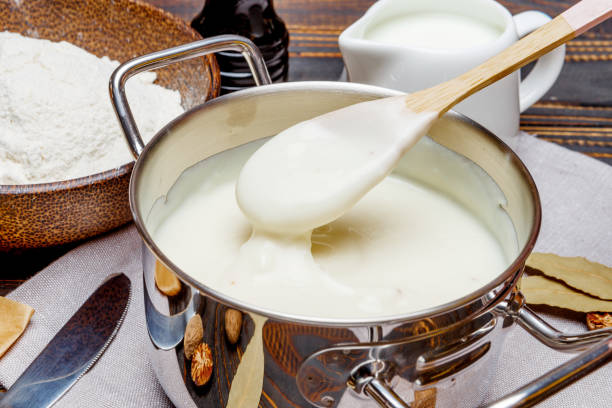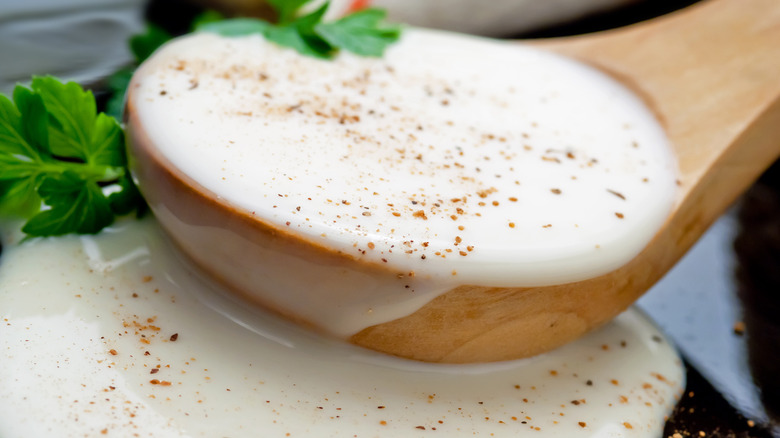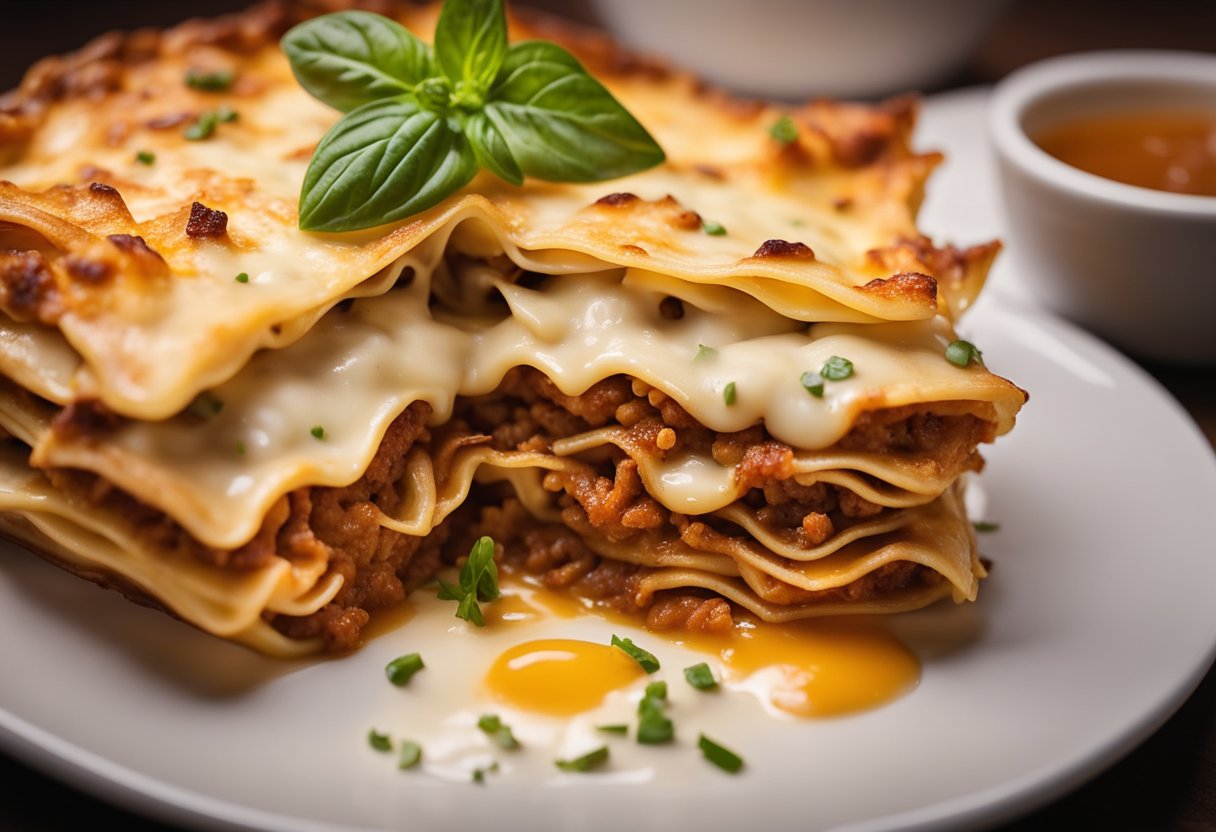Bechamel sauce, also known as white sauce, is a classic French sauce recognized for its creamy texture and mild flavor. It is an essential ingredient in many dishes such as lasagna and casseroles and serves as a base for various other sauces.
However, there may be instances when you need a suitable substitute for bechamel sauce, such as dietary restrictions, personal preferences, or when you run out of ingredients.
The quest for the perfect bechamel sauce substitute can be daunting, as there are many factors to consider, such as the role of the sauce in your dish, the desired texture, and flavor compatibility.
Identifying the properties and function of bechamel sauce can be the key to finding the most suitable alternative without compromising the overall outcome of your dish.
As you explore possible bechamel sauce substitutes, it is essential to take into account the unique characteristics of the alternatives, how they affect the dish, and any adjustments needed in preparation and cooking techniques.
To help you make an informed decision, we have summarized some crucial information in the following key takeaways.
Key Takeaways
- Bechamel sauce has specific properties that should be considered when selecting a suitable substitute.
- Various dietary needs and preferences can be accommodated with different bechamel sauce alternatives.
- Proper preparation techniques play a crucial role in the success of using an alternative sauce.
Understanding Bechamel Sauce
Bechamel sauce, also known as béchamel sauce, is a classic French cuisine staple and one of the five essential “mother sauces.” It forms the foundation for many delicious and creamy dishes in various cuisines.
This sauce is made from a combination of roux— a mixture of butter and flour— whisked together with milk, often seasoned with a hint of nutmeg.
The roux is the key component in creating a bechamel sauce. It begins by melting butter in a saucepan, and then whisking in an equal amount of flour. This mixture is cooked until it achieves a pale golden color.
The purpose of the roux is to thicken the sauce and provide a smooth, velvety texture. This thickening process occurs when the starch in the flour absorbs liquid, in this case, milk.
Preparing the bechamel sauce involves gradually adding the milk to the roux while continuously whisking the mixture. This process ensures there are no lumps, resulting in a silky sauce.
The milk is the primary liquid component in the sauce. The amount of milk added to the roux determines the final thickness of the sauce. A proper bechamel sauce should be thick enough to coat the back of a spoon.
Seasoning plays an essential role in the bechamel sauce. A dash of nutmeg is a commonly used spice to enhance the flavor. Salt and white pepper can also be added to taste.
Some variations of the sauce may include cheese, creating a rich and more decadent sauce to accompany pasta dishes, vegetables, or baked dishes like lasagna.
In conclusion, understanding the process of making bechamel sauce and the critical components— roux, milk, and seasoning— is crucial for creating a successful and flavorful base for various dishes in both French cuisine and beyond.
Identifying the Necessity and Role of Bechamel Sauce in Various Dishes
Bechamel sauce, also known as white sauce, is a versatile and essential component in many classic dishes. It is one of the five mother sauces in French cuisine and serves as a base for other sauces like cream sauce, Mornay sauce, and soubise sauce.
Understanding its role in various dishes will help determine suitable substitutes when needed.
In lasagna, bechamel sauce plays a crucial role in providing a creamy and rich texture that complements the layers of pasta, meat, and cheese.
The smooth consistency not only adds flavor but also helps maintain the structure of the dish. Similarly, in baked pasta dishes and savory pies, bechamel sauce acts as a binder and creates a moist, tender texture, preventing the dish from becoming too dry.
When it comes to creamy dishes like macaroni and cheese, the white sauce is a key element in creating the perfect cheese sauce. By combining bechamel sauce with shredded cheese, an even, velvety cheese sauce is achieved, which coats the macaroni and provides that classic comfort food taste.
The versatility of bechamel sauce extends to other dishes, such as crepes and quiche. In crepes, it can be used as a filling mixed with vegetables or meat, adding richness and depth. For quiche, the sauce is an essential ingredient in the custard base, providing a creamy and stable foundation for the savory fillings.
Given the diverse use of bechamel sauce in various dishes, it is essential to identify the appropriate substitutes depending on the dish being prepared. Consider factors such as consistency, flavor, and the desired end result to choose the right alternative.
Understanding Properties of Bechamel Sauce

Bechamel sauce, also known as white sauce, is a classic French sauce made from a roux of butter and flour, combined with milk.
It is often used as a base for other sauces, such as Mornay sauce, which is a Bechamel sauce with added cheese. Understanding the properties of Bechamel sauce can aid in finding suitable substitutes.
The primary component of Bechamel is fat, derived from the butter used in the roux. This fat content is responsible for the sauce’s rich and creamy texture. It is essential to pay attention to the fat content when looking for a substitute, as it provides mouthfeel and smoothness to the finished dish.
Another vital aspect of Bechamel sauce is its protein content, which comes predominantly from the milk. The protein in milk helps to stabilize the sauce and create a smooth consistency.
Additionally, the protein can contribute to the sauce’s nutritional value, complementing the macronutrients of the overall dish.
Bechamel sauce can have a relatively high calorie count due to the presence of fat, protein, and carbohydrates from the butter, milk, and flour. For those looking to decrease the caloric content of their dishes, finding a substitute that maintains the flavor profile while limiting the number of calories is crucial.
A significant concern for some individuals is Bechamel sauce’s cholesterol content. Cholesterol is found in the dairy products used in the sauce, with both saturated and unsaturated fats present. Saturated fats are typically seen as unfavorable for heart health, while unsaturated fats can be beneficial.
When seeking a substitute, being mindful of the fat types and cholesterol levels is necessary for those with heart-related health concerns.
In conclusion, understanding the properties of Bechamel sauce – particularly its fat, protein, and cholesterol content – is essential when seeking suitable substitutes.
By considering these factors, it’s possible to maintain the intended flavor, texture, and nutritional values of a dish while making health-conscious choices or accommodating dietary restrictions.
Common Issues with Bechamel Sauce

Bechamel sauce, a classic white sauce made from butter, flour, and milk, is often used as a base for many dishes. However, there are some common issues that may arise when making bechamel sauce.
Lumps: One of the most common issues encountered is the formation of lumps. This occurs when the flour and butter mixture is not whisked properly or if the milk is added too quickly. To avoid this issue, ensure that the roux is cooked evenly and whisked continuously as the milk is gradually poured in.
Sodium: Bechamel sauce can be high in sodium, particularly if excessive amounts of salt are used in the preparation. To reduce sodium levels, reduce the amount of salt added during cooking or use low-sodium products like unsalted butter and milk.
Allergy: Those with dairy allergies or lactose intolerance may have difficulty consuming dishes containing bechamel sauce. To address this concern, try using lactose-free milk, dairy-free alternatives like almond milk, or even vegetable broth for a completely dairy-free option.
High cholesterol: Bechamel sauce, being a dairy-based sauce, can contribute to high cholesterol levels due to saturated fat content. A way to reduce cholesterol levels is by using healthier alternatives such as olive oil instead of butter and fat-free milk instead of whole milk.
Caloric intake: Due to its rich ingredients and buttery base, bechamel sauce can be high in calories. To maintain the creamy texture while reducing caloric content, use lower-fat dairy products or consider adding cauliflower purée as a lighter option.
In summary, it’s essential to be aware of these common issues when making bechamel sauce. By addressing these concerns, it is possible to create a bechamel sauce that aligns with one’s dietary needs and preferences while still maintaining its classic, creamy taste.
Nutrition Facts and Health Implications
Bechamel sauce substitutes come in various forms, each offering distinct nutritional values and potential health implications. It is essential to consider the primary constituents of these alternatives to make an informed choice based on dietary preferences and health considerations.
Almond Milk and Flour: A popular dairy-free option, almond milk and flour provide a creamy consistency similar to traditional bechamel sauce.
Almond milk is low in calories, carbohydrates, and sugar but a good source of protein, potassium, and healthy fats. However, it may also contain higher sodium levels compared to dairy milk.
Greek Yogurt: A protein-rich substitute for bechamel sauce, Greek yogurt can contribute to muscle growth and repair. It also contains probiotics, supporting gut health.
Low in carbohydrates, sugar, and cholesterol, Greek yogurt is an ideal choice for weight management. However, it may lack sufficient fiber and potassium content.
Cauliflower Puree: A low-carbohydrate option, cauliflower puree is suitable for those following a ketogenic or low-carb diet.
Cauliflower is high in fiber, beneficial for digestion, and potassium, essential for heart health while having low sugar content. Though providing limited protein and sodium, it compensates with vitamins C and K.
White Bean Puree: This substitution is high in plant-based protein, fiber, and potassium, contributing to overall well-being. It is also low in sugar and sodium, making it heart-friendly. However, individuals with bean allergies or intolerances may need to explore other options.
Tofu: An excellent choice for vegans and sufferers of lactose intolerance, tofu offers adequate amounts of protein, calcium, and iron. Low in carbohydrates and cholesterol, it may be preferable for those with heart-related concerns or diabetes.
However, it lacks significant fiber, potassium, and may have increased sodium content depending on the preparation method.
In summary, each bechamel sauce substitute has its unique nutritional profile and potential health implications. Making the right decision depends on individual dietary preferences, health goals, and possible allergens.
Vegan and Dairy-Free Substitutes
For those following a vegan or dairy-free lifestyle, finding a suitable substitute for béchamel sauce can be challenging. However, there are a few alternatives that can mimic the creamy texture and taste of traditional béchamel while being both vegan and dairy-free.
One such option is a vegan cheese sauce made from cashews. Cashews, when soaked and blended, create a smooth and creamy base that can be seasoned to taste similar to béchamel sauce.
To make this sauce, blend soaked cashews with water, nutritional yeast, garlic, salt, and pepper until smooth. Adjust seasonings to taste and heat as needed.
Another dairy-free option is a white bean sauce that can be easily modified to be vegan. To make, blend cooked white beans with almond milk, garlic, and seasonings until smooth. Heat the sauce over medium heat and adjust the consistency with more almond milk, if needed.
The white bean sauce provides a protein-packed alternative that still offers a rich and creamy texture.
For those looking for a vegan and gluten-free béchamel substitute, consider using a cauliflower-based sauce. Simply blend steamed cauliflower with non-dairy milk, garlic, and seasonings until smooth. The resulting sauce is both creamy and delicious, while being allergen-friendly.
As for vegan cheese, a homemade ricotta cheese substitute can be made from tofu. To prepare, crumble firm tofu and mix it with lemon juice, nutritional yeast, garlic powder, salt, and pepper. This tofu “ricotta” can be incorporated into recipes that call for béchamel sauce, providing a dairy-free and vegan cheese alternative.
In summary, there are several vegan and dairy-free substitutes for béchamel sauce that can be easily made at home. From cashew cheese sauce and white bean sauce to cauliflower-based sauce and tofu ricotta, these alternatives cater to various dietary needs while offering satisfying taste and texture.
Non-Dairy Milk Substitutes for Bechamel Sauce
When looking for a non-dairy milk substitute for bechamel sauce, it’s essential to consider the flavor, consistency, and nutritional profile of various options. Here are some popular non-dairy milk options that can be used as substitutes for bechamel sauce:
Rice Milk: Made from rice and water, rice milk offers a mild and slightly sweet flavor. Its thin consistency makes it an excellent choice for those who prefer a lighter bechamel sauce.
To achieve a thicker consistency similar to traditional bechamel, you may need to use more flour or a thickening agent in the sauce. Rice milk is low in fat and protein, making it suitable for those on low-fat diets.
Soy Milk: Soy milk is made from ground soybeans and water, resulting in a creamy consistency that closely resembles cow’s milk. Its neutral flavor and richness make it an ideal substitute for bechamel sauce. Due to its high protein content, soy milk often thickens well when heated, resulting in a creamy sauce without the need for additional thickeners.
Almond Milk: Almond milk is derived from ground almonds and water. It has a nutty and slightly sweet flavor, which may add a unique twist to your bechamel sauce.
Almond milk is relatively low in calories and fat compared to cow’s milk but may require additional thickeners to achieve the desired consistency for bechamel sauce. This option may not be suitable for individuals with nut allergies.
Coconut Milk: Made from the grated flesh of coconuts and water, coconut milk is known for its rich texture and slightly sweet taste. Its high-fat content makes it an excellent option for creating a creamy, thick bechamel sauce. However, the distinct coconut flavor may not be preferred by all, and it can alter the desired taste of your dish.
Oat Milk: Oat milk is produced by blending oats and water, creating a creamy and slightly sweet option for bechamel sauce. Its naturally thick consistency can hold up well in sauces, often without the need for additional thickeners. Oat milk is a good source of fiber and provides a smooth texture without overpowering the dish with extra flavors.
In conclusion, various non-dairy milk options can serve as suitable substitutes for bechamel sauce. Each option offers unique flavors and textures, so consider your specific dietary needs and preferences when choosing the best substitute for your dish.
Potential Bechamel Sauce Substitutes
Bechamel sauce, a white sauce made from butter, flour, and milk, is a staple in many cuisines. However, there might be instances where one would need a substitute for various reasons, such as dietary restrictions or unavailability of ingredients.
Here are some bechamel sauce substitutes that can be used in a wide range of dishes.
Cream can be a simple alternative to bechamel sauce, providing a rich and velvety texture. One can use heavy cream, or for a lighter option, opt for half-and-half or whole milk.
Adding herbs, spices, or grated cheese can also further enhance the flavor of the cream. This substitution works exceptionally well in gratins, lasagna, and casseroles.
Yogurt is another bechamel sauce substitute that can offer a slightly tangy flavor and creamy texture. Greek yogurt or plain yogurt can be used, but it is essential to cook it gently to prevent curdling.
A small amount of cornstarch may be added to yogurt to help it withstand heat better. This option works well in au gratin dishes, pasta bakes, or moussaka.
Using olive oil as a base, one can create a roux-like consistency by whisking in an equal amount of flour and gradually adding milk or a non-dairy alternative such as almond milk. This can be a healthier option for those looking to cut down on saturated fats while still achieving a thick, creamy sauce.
Cauliflower cream sauce is a more health-conscious and vegan alternative to traditional bechamel. Made by blending steamed cauliflower with olive oil, vegetable broth, and seasonings, it offers a smooth and creamy texture. This substitution is an ideal choice for those following specific diets or looking to add more vegetables to their meals.
White wine sauce can elevate the flavors of a dish, providing a tangier alternative to bechamel sauce. Combining white wine, butter, and flour creates a rich, smooth sauce that complements seafood, chicken, or vegetable-based dishes. This is ideal for those seeking a more sophisticated touch in their cooking.
Hollandaise sauce, made from egg yolks, butter, and lemon juice, also serves as a bechamel sauce substitute in certain recipes. Its uniquely rich and buttery flavor is particularly suitable for dishes such as Eggs Benedict, asparagus, or other vegetables and fish.
Tomato sauce is a versatile alternative that adds a touch of acidity to a dish. This option can be an excellent choice for those who enjoy the red sauce style in their Italian recipes, replacing bechamel in dishes like lasagna. It can be made using canned tomatoes, olive oil, garlic, onions, and herbs.
These bechamel sauce substitutes offer plenty of variety for different palates and dietary needs, allowing the adaptation of various recipes without sacrificing flavor or texture.
Considerations When Choosing a Bechamel Sauce Substitute

When looking for a bechamel sauce substitute, it’s important to consider the specific needs of the recipe. Bechamel sauce is a classic French sauce made from a roux (a mixture of butter and all-purpose flour) and milk, creating a creamy texture.
The choice of substitute largely depends on the dish you are preparing and any dietary constraints or intolerances.
First, consider the role of the bechamel sauce in the recipe. If it serves as a binder, such as in a lasagna or a gratin, a thick and creamy alternative is necessary.
A suitable option may be a soubise sauce, which is made from onions and a roux, or a simple mixture of all-purpose flour and water. The latter may lack the richness of a traditional bechamel, so additional spices can be added to enhance flavor.
Allergies and intolerances should also be kept in mind. For individuals avoiding all-purpose flour, a gluten-free flour blend or cornstarch can be used as a thickening agent in place of the standard roux.
Keep in mind that some gluten-free flours may affect the taste or texture of the sauce. For a dairy-free option, a pureed, cooked vegetable such as cauliflower or squash, combined with a dairy-free milk, can mimic the consistency and texture of bechamel.
Think about your preferred cooking method, as this can also impact the choice of substitute. Some options may require additional equipment, such as a microwave or a freezer. Keep in mind your available resources and time constraints when selecting your bechamel replacement.
Moreover, it’s essential to properly store the chosen substitute before use. Depending on the specific ingredients and preparation, the sauce may need to be kept in the refrigerator or freezer for optimal freshness and food safety.
Be sure to follow the directions for the chosen recipe when it comes to storage and handling.
In summary, selecting the best bechamel sauce substitute involves taking into account the dish you are preparing, any dietary needs or intolerances, your available tools, and proper storage techniques.
By considering these factors, you can confidently choose a suitable alternative that will complement your recipe and satisfy your preferences.
Preparation and Cooking Techniques for Alternative Sauces
When considering alternative sauces to Bechamel, it is essential to understand the various preparation and cooking techniques involved. In this section, we will discuss some methods that cater to these substitutes.
To begin, gather all the necessary ingredients for your chosen alternative sauce. You may use a variety of vegetables, such as garlic, onion, or others depending on the desired flavor. Options for cheeses include parmesan, cheddar, or gruyere.
Before turning on the heat, prepare your saucepan or pot. Melt an appropriate amount of unsalted butter, which will form the base for your sauce. Be sure not to overheat and burn the butter, as it can affect the overall taste.
Once the butter has melted, sauté the vegetables (garlic, onion, etc.) in the saucepan until they become soft and translucent. This step will release their flavors and create a more aromatic and rich alternative sauce.
Next, add the desired cheese(s) to the saucepan and gently stir until everything is well combined. It is essential to continually whisk the sauce while it cooks to avoid any lumps or separation. If you are using white sauce as a Bechamel substitute, follow a similar process to incorporate the cheese into the sauce, making sure to stir continuously.
Add salt, pepper, and other seasonings as needed, adjusting the taste to your preference. Keep in mind that certain cheeses, such as parmesan, tend to have a higher salt content. As a result, be mindful of the existing salt levels in your sauce before adding more.
Once your alternative sauce has reached a smooth consistency, it can be incorporated into your dish. Be it pasta, lasagna, or any other culinary creation, these sauces can provide versatility and unique flavors to your cooking.
Overall, mastering the preparation and cooking techniques for alternative sauces to Bechamel enables you to broaden your culinary repertoire. By using different ingredients and adhering to the appropriate cooking methods, you can create satisfying sauces to elevate your dishes.
Frequently Asked Questions
What can replace bechamel sauce in lasagna?
You can try using a ricotta cheese mixture as a substitute for bechamel sauce in lasagna. Combine ricotta cheese, eggs, and seasoning, like salt, pepper, and Italian herbs. Spread this mixture between the lasagna layers, ensuring a creamy and tasty alternative to the traditional bechamel sauce.
How to make an alternative cheese sauce for lasagna?
If you’re looking for a different cheese sauce for lasagna, consider making a simple cheddar cheese sauce. Melt butter in a saucepan, add flour, and cook for a minute or two.
Gradually whisk in milk until you have a smooth sauce. Bring to a low boil, then add grated cheddar cheese until melted and well combined. Season with salt, pepper, and nutmeg to taste.
Is flour substitution possible for making bechamel sauce?
Yes, you can substitute all-purpose flour with other alternatives when making bechamel sauce. Gluten-free options like cornstarch, rice flour, or gluten-free all-purpose flour can be used. Remember the ratios might be different, so adjust accordingly, and ensure the roux’s consistency is smooth before adding milk into it.
Can Alfredo sauce be used as a bechamel substitute?
Although they have different flavors, Alfredo sauce can be used as a substitute for bechamel sauce in some recipes. Alfredo sauce is made with butter, heavy cream, and Parmesan cheese, which together provide a creamy and rich taste.
Keep in mind that Alfredo sauce might slightly change the final dish flavor profile compared to using bechamel sauce.
Is it possible to make lasagna without a white sauce?
Yes, it is possible to make lasagna without a white sauce. You can use tomato-based sauces or opt for cheese and vegetable layers instead. For example, add a layer of sautéed spinach and mushrooms or roasted vegetables along with ricotta cheese and mozzarella cheese to create a flavorful lasagna without a white sauce component.
Are bechamel sauce and heavy cream the same?
No, bechamel sauce and heavy cream are not the same. Bechamel sauce is a white sauce made from a roux (butter and flour mixture) combined with milk and typically seasoned with nutmeg, salt, and white pepper.
On the other hand, heavy cream is a dairy product that has a higher fat content compared to milk and is often used as a base for whipping cream, ice cream, and various sauces.







